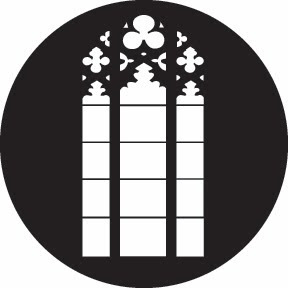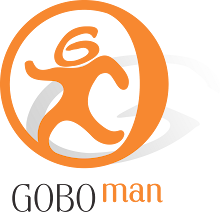The use of patterns, also known as gobos or cookies, is probably one of the best ways to add visual interest and depth to any lighting design. Lighting designers are often called upon to help set not only the time and place, but also the mood and tone of a scene. One of the most versatile tools in the designer’s arsenal is pattern projection, not only because there are several thousand off the shelf, or stock, patterns available for purchase, but because each gobo can be used in a variety of different ways to create different looks. And with the advent of custom gobos, which allows a designer the ability to turn virtually any image into a pattern, possibilities are limited only by the scope of one’s imagination.
A lighting designer can use gobos to create stunning visual compositions. From a leaf pattern taken out of focus and used to gently add a dappled effect to the floor or a set piece, to stark, sharply focused bars of light that shoot across a stage to highlight an actor or dancer as he moves through space, patterns and their uses are myriad.
Subtle use of patterns created the backdrop of light behind the dancers
Stark, sharply focused patterns create a dramatic look.
Patterns can only be used in lighting fixtures that allow you to focus the beam of light. Primarily, the fixtures used for gobo projection are Ellipsoidal Reflector Spotlights, so named because they have a reflector that is shaped like a portion of an ellipse, wrapping around the lamp nearly 240 degrees. This feature, along with a pair of plano-convex lenes, allow one to focus on an image. The optics are similar to those of a human eye. You may remember the diagram on how vision works from your middle school science textbooks.
Imagine that the eye in the diagram here is your lighting fixture. The upside down bicycle inside the eye is the gobo placed in the gate. Images must be places in the gate upside down and backward for the design to appear right onstage.
It was not long ago that patterns for theatrical lighting were all made by hand. Even long after conventional off the shelf patterns were made readily available, students and budget conscious individuals everywhere still liked to make their own gobos. One of the easiest ways to do this was to use pie tins- the heavy duty aluminum kind that come three to a pack in the cooking aisle at the grocery store. If one were lucky, one could appropriate some used printer’s tin from the local newspaper. Then all one had to do was cut the appropriately sized circle, and trace and cut out the desired design. This was laborious and time consuming, and lacked the fine detail today’s patterns provide so well.
GAMPRODUCTS, Inc. was one of the first, if not the first, company to provide a line of off the shelf patterns for purchase by end users. Companies such as Rosco, Lee Filters, Apollo and GoboMan soon followed. Several companies producing stock patterns ensures a wide variety of designs available to suit any designer’s palette.
There are several different ways to create a steel gobo. Some companies use a stamping process. This involves using a machine to cut the design out of the steel, creating a stencil, more or less. The drawback of stamping gobos is that you can not have a lot of detail. The simpler the design, the better. The end result was a gobo that tended to look a lot like a home made one, but with cleaner lines and smoother edges. None of the major companies use stamping anymore, although you’ll still find stamped gobos in less expensive lighting packs that include several gobos in a kit. Ikea had a pretty nice, cheap model a year or so ago. Laser cutting is another method. It’s a bit more precise and allows for more detail, but by and large, acid etching is the preferred method. Acid etching, also known as chemical milling, involves a process in which the designs are actually put onto film negatives and applied to steel that has been coated with a light sensitive protective lacquer. These are then dipped into an acid solution. The acid eats away the material on the negative not covered by the protective lacquer, resulting in a pattern that can be as highly detailed and intricate as one likes. I’ve fairly glossed over the process here, because the truth is, it’s also a highly detailed and intricate process that involves many steps and safety precautions. There was a company a while back that sold a Do-It-Yourself acid etching gobo making kit. I don’t have any data on how disastrous that was, but let me go on record as saying that mixing corrosive agents at home in your spare time is not a good use of your weekend.
In recent years there have been many wonderful advances made in not only gobo creation, but in the instruments used to project patterns. The newer instrumentation is significant because without it, we’d still be stuck in a black and white world as far as image projection was concerned. (For purposes of this article, I’m omitting references to the use of gel to color light) The old workhorses of theatrical lighting, the Strand Century Ellipsoidals and Altman KLs and 360Qs were extremely hot in the gate area, the area in the middle of the light where the gobo is inserted. Often, the gate would reach temperatures of close to 1600 degrees. Gobos would turn red hot, sometimes distorting radically, and sometimes burning a hole straight through.
In the early nineties, new technology ushered in new instruments that were brighter, cooler and more efficient. The ETC Source Four and the Altman Shakespeare are two such instruments that quickly became industry standards. The gate area in these new ellipsoidals only reach temperatures of around 500 degrees. Now, in addition to regular steel gobos, we have mesh, or halftone gobos which use a dot pattern to create an image. When used for cloud and moon gobos, the effect created is much softer and more realistic looking than a cloud shape or circle to represent a moon cut into steel.
Regular and halftone cloud gobos
Manufacturers now have the ability to create glass gobos, which gives the lighting designer a full range of color that before was not possible in gobo projection.
There are several companies today that offer a line of colored stock patterns. Rosco Labs was the first that I know of to offer a collection of colored glass gobos, followed soon after by Apollo. Colored glass patterns display a range of creative options from simple to ornate. The stock Rosco Prizmatics, pictured below, are created by applying chips of dichroic glass to the glass surface. When placed in the gate, you can get a sharp focus on each individual color, or you can soften the focus to create a multi-hued pallete.
More intricate designs such as these, from Rosco’s Signature series, allow a designer to really experiment with the use of color in patterns.
Glass gobos aren’t limited to color, as evidenced by Rosco’s line of Image Glass, which give you a very soft pattern uniquely different from black and white steel and halftone designs.
Even with the thousands of stock patterns available, many designers feel the need to create custom images that will be unique to their event or production. Nearly every industry that deals directly with lighting has seen the possibilities inherent in creating custom images. Stores and business project their logos. Wedding planners project the names of the wedding couple at the reception, Churches project images of worship. Theatre designers like to create custom images relevant to the time and mood of the production. The possibilities are truly endless.
One of the best companies for custom metal gobos is N&N Productions in Nevada. They use brass instead of steel, and the quality they turn out is excellent.
There are several companies that offer custom glass gobo services, but the process and results are all fairly similar. These companies also offer custom steel gobos, which gives the consumer a choice in price and workmanship. Custom steel (or brass, at N&N) are the most cost effective option, as they are significantly lower in price than glass. One distinctive feature of a custom steel image is that you do basically have a design that is, in appearance, a stencil. Words and images have to be etched into the steel, so support tabs are needed to hold in the centers of letters and more intricate designs. Also, you get an image that is reversed from the original. Imagine a word, in black ink, on a white page. Transferred to a gobo, you have a white light word on a field of black.
It can’t be the reverse, because then the letters would need to float in space, which, as we know, is not going to happen. (I blame Newton.)
The only way around these issues is to upgrade to a glass black and white gobo. With the glass, the design is etched into the glass, but not all the way through, so you don’t need tabs to hold in centers. You can also design a black word in a pool of white light.
When you move into colored glass, you can really go nuts. Manufacturers usually divide colored glass gobos into four tiers: one color, two color, multi color, which would be, of course, three or more colors, and photo-realistic, in which your completed product looks exactly like the photograph you sent in. The price for each tier goes up accordingly.
All of the manufacturers have tried to make the ordering process for custom gobos as easy and hassle free as possible. But some general knowledge on the part of the designer is required for a smooth process to actually occur. It helps considerably to know what size gobo is needed, and which fixture you plan to use. The ETC Source Four, for example, will take two different sized gobos, depending on your pattern holder size and your personal preference. The fixtures nowadays that accept gobos range in size from small to large, as do the gobos that fit into them. Gobo sizing is primarily done in letters. “A” size “B” size and “M” size are most common for theatre. The retail and architectural world, as well as moving light fixtures tend to use “E” and “D” size, and there are smaller sizes for moving lights. The manufacturer of your choice can provide you with the details needed. In general, the artwork submitted should be a jpg or better. Eps files are among the best. Faxed artwork has a tendency to distort or get fuzzy. Some manufacturers won’t accept faxed artwork. If your design is purely text, let your manufacturer know which font you have chosen. If it’s not a standard font, the manufacturer’s computer may switch it to a more common font without warning anyone, and the manufacturer will have no way of knowing if the newly selected font is even close to the one you’d chosen.
Patterns are a dynamic way to add visual interest to a lighting design. They’re a versatile tool that’s relatively easy to learn to use, and provide a wealth of opportunities for creative expression. Whether you’re experimenting with stock patterns and focal ranges, or designing intricate custom work, let your imagination be your guide. If you need help, the manufacturer of your choice can provide any assistance you require.
Some helpful links:
http://www.goboman.com/


-1.jpg)





-2.jpg)





























